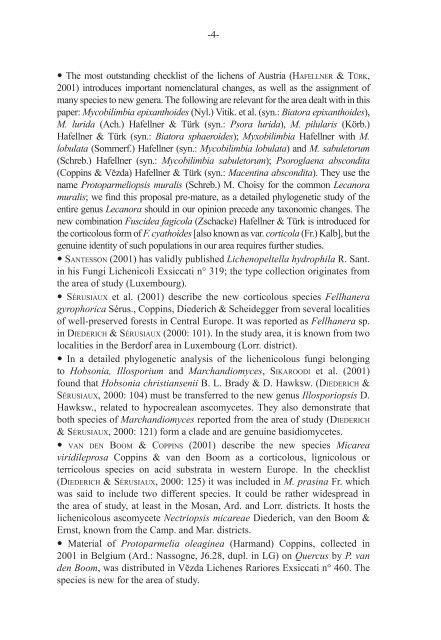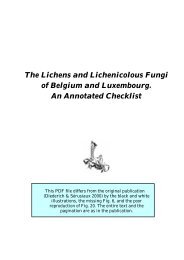LEJEUNIA - Lichens of Belgium, Luxembourg and northern France
LEJEUNIA - Lichens of Belgium, Luxembourg and northern France
LEJEUNIA - Lichens of Belgium, Luxembourg and northern France
You also want an ePaper? Increase the reach of your titles
YUMPU automatically turns print PDFs into web optimized ePapers that Google loves.
-4-<br />
The most outst<strong>and</strong>ing checklist <strong>of</strong> the lichens <strong>of</strong> Austria (HAFELLNER & TÜRK,<br />
2001) introduces important nomenclatural changes, as well as the assignment <strong>of</strong><br />
many species to new genera. The following are relevant for the area dealt with in this<br />
paper: Mycobilimbia epixanthoides (Nyl.) Vitik. et al. (syn.: Biatora epixanthoides),<br />
M. lurida (Ach.) Hafellner & Türk (syn.: Psora lurida), M. pilularis (Körb.)<br />
Hafellner & Türk (syn.: Biatora sphaeroides); Myxobilimbia Hafellner with M.<br />
lobulata (Sommerf.) Hafellner (syn.: Mycobilimbia lobulata) <strong>and</strong> M. sabuletorum<br />
(Schreb.) Hafellner (syn.: Mycobilimbia sabuletorum); Psoroglaena abscondita<br />
(Coppins & Vĕzda) Hafellner & Türk (syn.: Macentina abscondita). They use the<br />
name Protoparmeliopsis muralis (Schreb.) M. Choisy for the common Lecanora<br />
muralis; we find this proposal pre-mature, as a detailed phylogenetic study <strong>of</strong> the<br />
entire genus Lecanora should in our opinion precede any taxonomic changes. The<br />
new combination Fuscidea fagicola (Zschacke) Hafellner & Türk is introduced for<br />
the corticolous form <strong>of</strong> F. cyathoides [also known as var. corticola (Fr.) Kalb], but the<br />
genuine identity <strong>of</strong> such populations in our area requires further studies.<br />
SANTESSON (2001) has validly published Lichenopeltella hydrophila R. Sant.<br />
in his Fungi Lichenicoli Exsiccati n° 319; the type collection originates from<br />
the area <strong>of</strong> study (<strong>Luxembourg</strong>).<br />
SÉRUSIAUX et al. (2001) describe the new corticolous species Fellhanera<br />
gyrophorica Sérus., Coppins, Diederich & Scheidegger from several localities<br />
<strong>of</strong> well-preserved forests in Central Europe. It was reported as Fellhanera sp.<br />
in DIEDERICH & SÉRUSIAUX (2000: 101). In the study area, it is known from two<br />
localities in the Berdorf area in <strong>Luxembourg</strong> (Lorr. district).<br />
In a detailed phylogenetic analysis <strong>of</strong> the lichenicolous fungi belonging<br />
to Hobsonia, Illosporium <strong>and</strong> March<strong>and</strong>iomyces, SIKAROODI et al. (2001)<br />
found that Hobsonia christiansenii B. L. Brady & D. Hawksw. (DIEDERICH &<br />
SÉRUSIAUX, 2000: 104) must be transferred to the new genus Illosporiopsis D.<br />
Hawksw., related to hypocrealean ascomycetes. They also demonstrate that<br />
both species <strong>of</strong> March<strong>and</strong>iomyces reported from the area <strong>of</strong> study (DIEDERICH<br />
& SÉRUSIAUX, 2000: 121) form a clade <strong>and</strong> are genuine basidiomycetes.<br />
VAN DEN BOOM & COPPINS (2001) describe the new species Micarea<br />
viridileprosa Coppins & van den Boom as a corticolous, lignicolous or<br />
terricolous species on acid substrata in western Europe. In the checklist<br />
(DIEDERICH & SÉRUSIAUX, 2000: 125) it was included in M. prasina Fr. which<br />
was said to include two different species. It could be rather widespread in<br />
the area <strong>of</strong> study, at least in the Mosan, Ard. <strong>and</strong> Lorr. districts. It hosts the<br />
lichenicolous ascomycete Nectriopsis micareae Diederich, van den Boom &<br />
Ernst, known from the Camp. <strong>and</strong> Mar. districts.<br />
Material <strong>of</strong> Protoparmelia oleaginea (Harm<strong>and</strong>) Coppins, collected in<br />
2001 in <strong>Belgium</strong> (Ard.: Nassogne, J6.28, dupl. in LG) on Quercus by P. van<br />
den Boom, was distributed in Vĕzda Lichenes Rariores Exsiccati n° 460. The<br />
species is new for the area <strong>of</strong> study.





